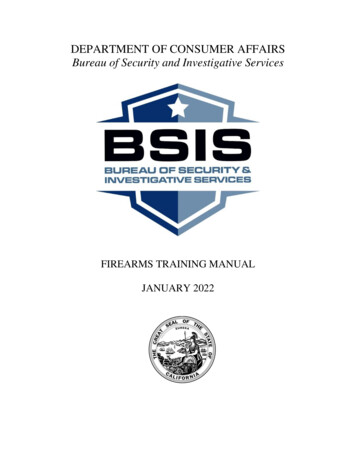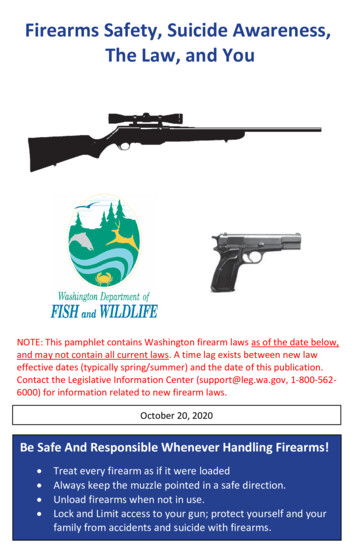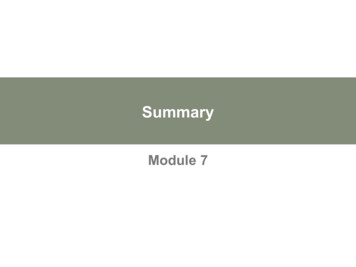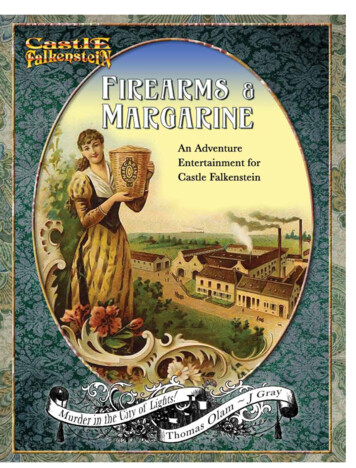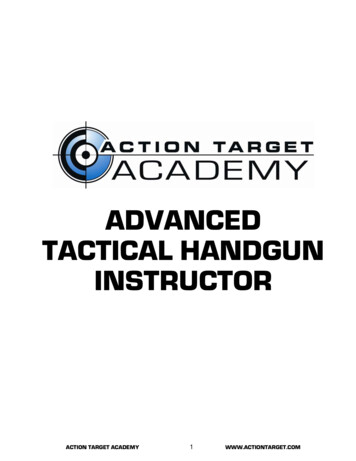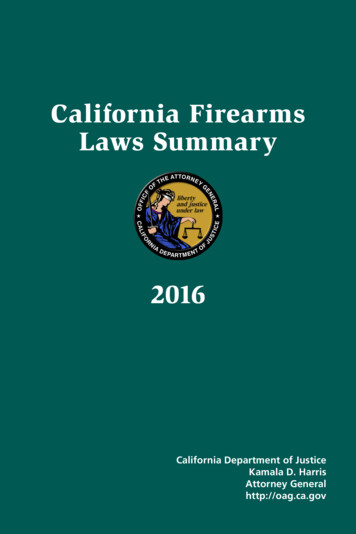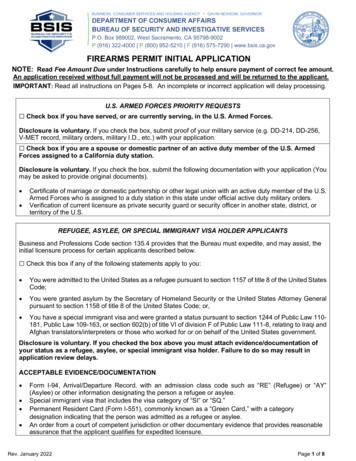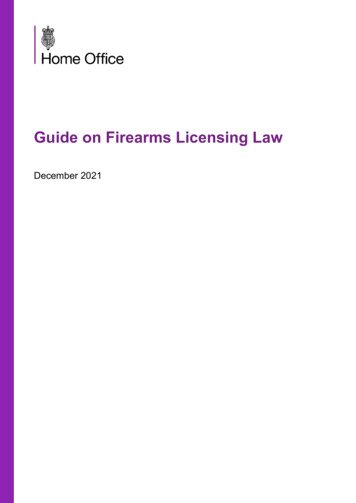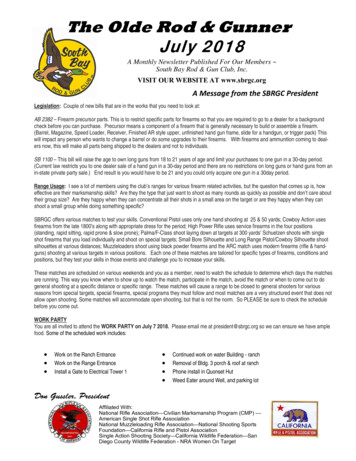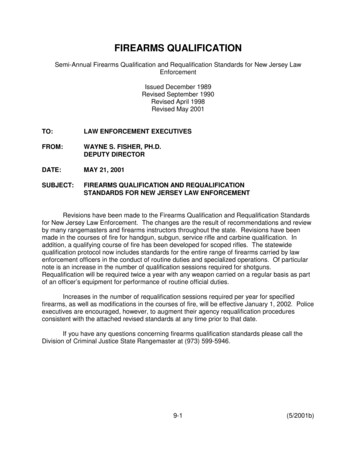
Transcription
FIREARMS QUALIFICATIONSemi-Annual Firearms Qualification and Requalification Standards for New Jersey LawEnforcementIssued December 1989Revised September 1990Revised April 1998Revised May 2001TO:LAW ENFORCEMENT EXECUTIVESFROM:WAYNE S. FISHER, PH.D.DEPUTY DIRECTORDATE:MAY 21, 2001SUBJECT:FIREARMS QUALIFICATION AND REQUALIFICATIONSTANDARDS FOR NEW JERSEY LAW ENFORCEMENTRevisions have been made to the Firearms Qualification and Requalification Standardsfor New Jersey Law Enforcement. The changes are the result of recommendations and reviewby many rangemasters and firearms instructors throughout the state. Revisions have beenmade in the courses of fire for handgun, subgun, service rifle and carbine qualification. Inaddition, a qualifying course of fire has been developed for scoped rifles. The statewidequalification protocol now includes standards for the entire range of firearms carried by lawenforcement officers in the conduct of routine duties and specialized operations. Of particularnote is an increase in the number of qualification sessions required for shotguns.Requalification will be required twice a year with any weapon carried on a regular basis as partof an officer’s equipment for performance of routine official duties.Increases in the number of requalification sessions required per year for specifiedfirearms, as well as modifications in the courses of fire, will be effective January 1, 2002. Policeexecutives are encouraged, however, to augment their agency requalification proceduresconsistent with the attached revised standards at any time prior to that date.If you have any questions concerning firearms qualification standards please call theDivision of Criminal Justice State Rangemaster at (973) 599-5946.9-1(5/2001b)
Semi-Annual Firearms Qualification and Requalification StandardsTO:ALL LAW ENFORCEMENT OFFICERSDATE:December 1, 1989SUBJECT:Semi-Annual Firearms Qualification and Requalification Standards for NewJersey Law EnforcementIn compliance with the instructions of Attorney General Peter N. Perretti, Jr. andpursuant to the Criminal Justice Act of 1970, N.J.S.A. 52:17B-97 et seq., effective January 1,1991 itis directed that all New Jersey law enforcement officers shall follow the attached SemiAnnual Firearms Qualification andRequalification Standards, and all New Jersey lawenforcement agencies shall adopt such standards as agency policy.The Attorney General's directive dated July 17, 1985 did not provide for specializedtraining with respect to automatic and semi-automatic assault weapons. Accordingly, all lawenforcement officers who are authorized to use such weapons shall comply with the provisionsof this manual concerning automatic and semi-automatic assault weapons commencing March1, 1990.Robert T. WinterDirector, Division of Criminal Justice9-2(5/2001b)
Semi-Annual Firearms Qualification and Requalification StandardsTO:ALL LAW ENFORCEMENT CHIEF EXECUTIVESSUBJECT:Semi-Annual Firearms Qualification and Requalification Standards for NewJersey Law EnforcementFollowing is the revised directive requiring all law enforcement officers to satisfactorilycomplete designated firearms qualification courses so that they may continue to lawfully carry afirearm in the State of New Jersey. This directive will be effective January 1, 1991.The previously issued directive, dated June 17, 1985, mandated semi-annual firearmsrequalification, provided an explanation of Tennessee v. Garner and outlined the firearmsrequalification program. That program included requirements for requalification with bothservice and off-duty weapons, along with requirements for systematic record keeping ofqualifying scores.The Semi-Annual Firearms Qualification and Requalification Manual, whichaccompanies the revised directive, provides the approved training and qualificationrequirements for law enforcement personnel exempt from the provisions of N.J.S.A. 2C:39-5.These requirements are necessary to meet the mandates of N.J.S.A. 2C:39-6J. Subsection J,which became effective on March 17, 1986, provides in part:A person shall qualify for an exemption from the provisions ofN.J.S.A. 2C:39-5, .if the person has satisfactorily completed afirearms training course approved by the Police TrainingCommission. Such exempt person shall not possess or carry afirearm until the person has satisfactorily completed a firearmstraining course and shall annually qualify in the use of a revolveror similar weapon.This new directive and accompanying manual augment the original directive andprovisions of N.J.S.A. 2C:39-6J by incorporating minimum standards for semi-annual firearmsqualification. This directive and qualification procedures shall be implemented by all NewJersey law enforcement agencies. The system of firearms qualification to be implemented isdesigned to measure basic firearms skills using uniform standards.The manual includes: standards for firearms qualification for revolvers, semi-automatichandguns and shotguns, as well as automatic and semi-automatic assault-type weapons. Themanual also includes training guidelines, procedures regarding non-qualifying participants,record keeping and reporting procedures, and requirements for firearms instructors.Officers must continue to qualify twice annually following the procedures andrequirements contained in the manual. These procedures do not prevent individual agenciesfrom conducting additional in-service firearms training. Agencies are encouraged to conductsupplemental training to meet the special needs of their personnel.9-3(5/2001b)
Semi-Annual Firearms Qualification and Requalification StandardsI therefore direct, as a matter of law enforcement policy, that effective January 1, 1991all officers must meet the minimum standards set forth in the Semi-Annual FirearmsQualification and Requalification Manual. Those personnel who do not successfully qualify orrequalify with firearms shall not be permitted to carry firearms.This directive is being issued to ensure the safety of law enforcement officers as well aspromote the public safety and ensure a high level of public confidence in the competence andintegrity of our law enforcement personnel in the performance of their official functions. Thisdirective is to be distributed to and adopted by all law enforcement personnel within the state.Robert Del TufoAttorney General9-4(5/2001b)
Semi-Annual Firearms Qualification and Requalification StandardsHANDGUN AND SHOTGUN QUALIFICATIONAND REQUALIFICATIONSection 1. General ProvisionsApplicability: This policy applies to all law enforcement personnel in New Jersey effectiveMarch 1, 2001.Supersession Notice: This policy supersedes the Attorney General's Directive of December,1998 and replaces those portions of the 21 county policies currently in place, as indicated inthis policy.Summary: This policy delineates the Attorney General's requirements on firearmsrequalification by establishing standards for the conduct of semi-annual firearms requalificationand associated training.Purpose: This policy is intended to establish a uniform set of standards for semi-annualfirearms requalification for any weapon, including a shotgun, which is issued or authorized foruse both on and off duty. It identifies specific courses of fire that meet firearm requalificationrequirements. It identifies the minimum score and training necessary to meet the requalificationstandards as set forth in this manual.On June 17, 1985, the Attorney General issued a directive requiring that all lawenforcement personnel requalify with their firearms at least twice a year pursuant to planssubmitted to and approved by the county prosecutor. This directive retains the twice a yearrequalification standard, augments the minimum standard now set forth in N.J.S.A. 2C:39-6J,and establishes a set of standards and requirements for requalification.Law enforcement personnel must, therefore, continue to qualify twice annually pursuantto this policy and to their respective county plans not affected or covered by this policy. Thispolicy is directed by the Attorney General, through the Division of Criminal Justice.Section 2. DefinitionsThe following words and terms, when used in this manual, shall have the followingmeanings unless the context clearly indicates otherwise.Ammunition.Equivalent load. Ammunition used in training programs that resembles the serviceload in size, weight, velocity, recoil and trajectory, but not carried as a duty round.Service load. Ammunition authorized by the agency and issued for duty use.9-5(5/2001b)
Semi-Annual Firearms Qualification and Requalification StandardsChief or Agency Executive. The chief executive officer of any law enforcement agency inNew Jersey.Firearms Instructor. An individual who is certified by the Police Training Commission toinstruct firearms in a basic recruit training program or possesses equivalent training as outlinedin Section 6 of this manual.Firearms Record. A record of firearms qualification activities for each officer required toparticipate. A record is to be completed, and maintained chronologically, each time the officeris required to qualify or requalify on a firearm. The record shall include relevant firearms data(make, model, caliber and serial number), training and qualification, location, date ofqualification activities, qualification courses completed, ammunition used, scores fired, name ofthe supervising firearms instructor, and other pertinent information.First Aider. This is a certified member of a volunteer first aid squad, a person certified as afirst responder or emergency medical technician, or someone who is otherwise adequatelytrained in first aid.Handgun. A firearm (semi-automatic or revolver) designed so that it can be held and fired withone hand.Handgun Qualification Courses (HQC1 or HQC2). Standardized courses of fire for semiannual handgun qualification for service and off-duty handguns. (Appendices A and B).Handgun Night Qualification Course (HNQC). A standard course of fire under night firingconditions for semi-annual qualification for service and off-duty handguns. (Appendix C).Law Enforcement Agency. Any police force or organization of a municipality, county or statewhich has, by statute or ordinance, the responsibility of detecting crime and enforcing thegeneral laws of the state.Night Firing Conditions. Low light conditions either under natural subdued lighting or utilizingsimulated subdued lighting.Non-Qualifying Participant. A person who fails to achieve a minimum passing score whilefiring a prescribed qualification course.Participant. An individual undergoing semi-annual firearms qualification.Qualification Score--Handgun. A score of 80% or higher based on one firing of a HandgunQualification Course (either HQC1 or HQC2) as contained in Appendices A and B.Qualification Score--Handgun Night Firing. A score of 70% or higher based on one firing ofthe Handgun Night Qualification Course (HNQC) as contained in Appendix C.9-6(5/2001b)
Semi-Annual Firearms Qualification and Requalification StandardsQualification Score--Shotgun. A score of 80% or higher based on one firing of the ShotgunQualification Course (SQC) as contained in Appendix D.Qualification Score--Shotgun Night Firing. A score of 80% or higher based on one firing ofthe Shotgun Night Qualification Course (SNQC) as contained in Appendix D.Semi-Annual Qualification. A program consisting of two prescribed qualification sessionswithin a 12-month period, with at least three months time between each qualification. Theprogram is to include semi-annual qualification with handguns and semi-annual qualificationwith the agency authorized shotgun utilizing standardized courses of fire under daylight andnight firing conditions.Shotgun. A smooth bore firearm that is specifically designed and capable of firing shotguncartridges.Shotgun Qualification Course (SQC). A standard course of fire for semi-annual qualificationfor shotguns as prescribed in this manual. (Appendix D).Shotgun Night Qualification Course (SNQC). A standard course of fire under night firingconditions for semi-annual qualification for shotguns as prescribed in this manual. (AppendixD).Supervising Firearms Instructor. An individual designated by the chief or agency executiveto conduct firearms qualification and supervise the firearms instructors and participants duringfirearms qualifications activities. The supervising firearms instructor must satisfy therequirements of a firearms instructor and must have experience in conducting either aPTC-approved firearms course or an equivalent course.Training/Qualification Schedule. Firearms training schedules that become part of thefirearms records reflecting the personnel, dates and times of semi-annual qualification activities.Section 3. Responsibilities1.2.Division of Criminal Justice: To establish a system of compliance, provide oversight for this policy andassist in implementing the policy statewide. To provide all necessary and reasonable assistance to law enforcementagencies affected by this policy.County Prosecutor:9-7(5/2001b)
Semi-Annual Firearms Qualification and Requalification Standards3. To implement the Attorney General's policy on firearms qualificationwithin the county jurisdiction, including reviewing qualification programsconducted by law enforcement agencies within the respective countyjurisdiction for consistency with statewide standards, conductingqualification programs as required, and maintaining proper records. To provide assistance to agencies within the county jurisdiction to enablethem to conduct training and qualification programs in accordance withthe standards established within this policy.State, County and Municipal Law Enforcement Agencies: To schedule and conduct individual semi-annual firearms qualificationprograms as directed by this policy. To maintain proper records as they relate to firearms qualification ofagency personnel. To take appropriate action with participants who fail to qualify. Thisaction is to be determined by the agency chief executive. To immediately notify the county prosecutor, or in the case of certainstate agencies the Division of Criminal Justice, of those participants whofail to qualify with a service weapon. To report annually to the county prosecutor, or in the case of certain stateagencies the Division of Criminal Justice, concerning qualificationactivities conducted during the year. (See Section 10. Records andReports). Every police agency within a county will report to theprosecutor of that county. To ensure compliance with the standards contained in this policy.Section 4. Agency Training and Qualification Requirements To conform to the requirements of N.J.S.A. 2C:39-6. To conduct semi-annual firearms qualification programs in conformancewith the standards set forth in this manual. To qualify, twice annually, on a Handgun Qualification Course (eitherHQC1 or HQC2) with a minimum score of 80% with the service handgun.(See Appendices A or B for courses of fire).9-8(5/2001b)
Semi-Annual Firearms Qualification and Requalification Standards To qualify, twice annually, on a Handgun Qualification Course (eitherHQC1 or HQC2) with a minimum score of 80% with any off-duty handgunwhich has been determined by the agency executive or supervisoryfirearms instructor to be substantially different in design, function orcaliber from the service handgun. (If an off-duty handgun does not differsubstantially in design, function, or caliber from the service handgun, aseparate qualification with this weapon is at the discretion of the agencyexecutive). To qualify, under night firing conditions, twice annually, on the HandgunNight Qualification Course (HNQC) with a score of 70% with the servicehandgun. (See Appendix C for course of fire). To qualify twice annually, under night firing conditions, on the HandgunNight Qualification Course (HNQC) with a minimum score of 70% withany off-duty handgun which has been determined by the agencyexecutive or supervising firearms instructor to be substantially different indesign, function or caliber from the service handgun. (If an off-dutyhandgun does not differ substantially in design, function or caliber fromthe service handgun, a separate qualification with this weapon is at thediscretion of the agency executive.) To qualify those officers who are or might be assigned use of an agencyissued shotgun twice annually on both the Shotgun Qualification Course(SQC) and the Shotgun Night Qualification Course (SNQC) with a scoreof 80% using the agency authorized shotgun. To provide remedial training for those personnel who do not meet thestandards of qualification or take appropriate action until such time as thequalification standards are met. To train, on a semi-annual basis, all personnel in the use of force,including an update in all state, county and agency policies, statutes, andcourt decisions dealing with the use of force. To review semi-annually all firearms policies as they relate to:1.2.3.4.5.6.7.8.Warning shotsMoving vehiclesRemoval of firearm from holster or display of firearmsSurrender of firearmDisposal of animalsCarrying of weapons, on and off dutyConsumption of alcohol, use of prescription drugsCovert operations9-9(5/2001b)
Semi-Annual Firearms Qualification and Requalification Standards To review semi-annually all relevant state, and municipal procedures forreporting the accidental or intentional discharge of a firearm while on oroff duty, except those fired in training. To develop and review semi-annually agency policies, rules andregulations defining:1.2.3.4. Official firearms and service ammunitionOff-duty firearmsService ammunitionLeather gear, to include loading devices for service and off-dutyfirearms.To provide agency personnel with appropriate training for specializedweapons such as rifles and other tactical weapons.Section 5. Qualification ProgramQualification. Qualification and requalification is required both during daylight hours and undernight firing conditions. All qualification sessions must be conducted under the supervision of aqualified supervising firearms instructor.Courses of Fire. Only those courses listed in this manual are to be used to meet the individualfirearms qualification requirements set forth by this policy. The use of cover may be used atany position other than the positions mandated, if resources allow. The use of multiple targetsduring qualification or requalification is permitted. Additional courses of fire and trainingprograms may be included in the agency schedule for firearms training. The purpose of thisprogram is not to prevent agencies from engaging in supplemental training courses that meettheir special needs. Specialty training is encouraged.Handgun Qualification Courses (HQC1 and HQC2). (See Appendices A and B). AHandgun Qualification Course must be completed two times a year for servicehandguns and for handguns authorized for use off duty and which are determined to besubstantially different in design, function or caliber from the service handgun. Thisdetermination is to be made by the agency executive or supervising firearms instructor.Either course, HQC1 or HQC2, may be selected for qualification purposes.If an off-duty handgun does not differ substantially in design, function or caliber from theservice handgun, a separate qualification with this weapon, under either daytime ornighttime conditions, is at the discretion of the agency executive.Handgun Night Qualification Course (HNQC). (See Appendix C). The HandgunNight Qualification Course is to be completed two times a year for service handguns andfor handguns authorized for use off duty and which are determined to be substantiallydifferent in design, function or caliber from the service handgun. This determination is9-10(5/2001b)
Semi-Annual Firearms Qualification and Requalification Standardsto be made by the agency executive or supervising firearms instructor. Either course,HQC1 or HQC2, may be selected for qualification purposes.If an off-duty handgun does not differ substantially in design, function or caliber from theservice handgun, a separate qualification with this weapon, under either daytime ornighttime conditions, is at the discretion of the agency executive.Shotgun Qualification Course (SQC). (See Appendix D). The Shotgun QualificationCourse is to be conducted semi-annually for the agency issued and approved shotgun.Shotgun Night Qualification Course (SNQC). (See Appendix D). The Shotgun NightQualification Course is to be conducted semi-annually for the agency issued andapproved shotgun.Participants should be advised of what is required for each course of fire and should beprovided with a copy of each course of fire and training program before going to the range.Supervising Firearms Instructor. The agency chief executive officer shall designate asupervising firearms instructor for each qualification session conducted.Firearms Instructor. Proper instructor-participant ratios should be maintained duringqualification sessions. (See Section 7. Supervising/Firearms Instructor Responsibilities).Ammunition. Each participant shall be provided with service or equivalent loads forqualification with agency or department issued firearms.Firearms. Qualification shall be conducted with a handgun approved by the participant'sagency. Shotgun qualification shall be conducted with the agency approved shotgun.Before any firearm is used, the supervising firearms instructor (or designee) shallinspect and approve the firearm. Approval of a firearm shall be based on department or agencystandards. The process of approving the service handgun, off-duty handgun or shotgun shallbe governed by the agency or department policy. A copy of records of approval shall be kepton file by the agency or department. Any off-duty handgun determined to be similar to theagency's service handgun and, therefore, not fired for qualification must be presented to thesupervising firearms instructor (or designee) for inspection during each of the agency'squalification periods.If a firearm is determined not to be serviceable, either prior to or during its use, thesupervising firearms instructor shall not allow the firearm to be used. The supervising instructorshall require the agency or department or the individual, in the case of an off-duty weapon, tofurnish a serviceable replacement. A report must be filed by the supervising instructor with theagency or department indicating why the firearm was unserviceable and what action was takento correct the problem.9-11(5/2001b)
Semi-Annual Firearms Qualification and Requalification StandardsEquipment. Each participant, prior to undergoing firearms qualification, must be equipped withthe agency authorized belt, holster, magazines, loading device and bullet loops. Thequalification course will be fired only with the use of agency authorized loading devices andequipment. This will be indicated on the qualification record form and training schedule.Clothing. Each participant should complete courses of fire wearing clothing similar to that wornwhile on duty. Uniformed and plain clothes personnel should wear the appropriate clothing andall equipment required in their respective assignments.Indoor Ranges. Agencies may utilize indoor ranges to meet the requirements of this policy.Range Conduct. Qualification on ranges will be conducted in accordance with therequirements listed in this policy.Section 6. Firearms Instructor Qualification RequirementsAll instructors (supervising firearms instructors and firearms instructors) engaged in theprescribed semi-annual firearms requalification program must satisfy one of the followingrequirements. An instructor must be certified by the Police Training Commission (PTC) toinstruct firearms in an approved "Basic Course" as defined in N.J.A.C. 13:1-1.1. An instructor must possess training equivalent to the PTC-approved firearmsinstructor course and be able to demonstrate knowledge and skill in this field.Equivalent training includes successful completion of a firearms instructortraining program such as offered by the Federal Bureau of Investigation, UnitedStates Secret Service, Federal Law Enforcement Training Center at Glynco,GA., New Jersey State Police, Smith and Wesson Academy or the National RifleAssociation Police Firearms Instructor Program. An instructor must have satisfactorily completed some other recognized firearmsinstructor course as determined by the chief of police or agency executive.Supervising firearms instructors must also have experience in conducting either aPTC-approved firearms course or an equivalent course.Section 7. Supervising/Firearms Instructor ResponsibilitiesThe supervising firearms instructor is responsible for: Conducting firearms activities in accordance with the standards set forth in thismanual.9-12(5/2001b)
Semi-Annual Firearms Qualification and Requalification Standards Ensuring the safety of all individuals engaged in firearms activities. Complyingwith all requirements set forth in this policy and manual with respect to allparticipants involved in qualification activities and training. Ensuring proper firearms instructor-participant ratios at all times on the firing line.The following ratios are recommended:1.2.3.One firearms instructor for six participants using handguns duringday-time firing.One firearms instructor for three participants using handguns duringnight-time firing conditions.One firearms instructor for each participant firing a shotgun. Ensuring that personnel equipped to provide first aid are present on the firearmsrange during all qualification activities. (This person can be a certified memberof a local volunteer first aid squad, an agency member certified as a firstresponder or emergency medical technician, or a member of the agency who isotherwise adequately trained.) Ensuring that adequate first aid supplies are on-site at all times. Ensuring that a suitable communications link exists between the firearms range,the local agency (especially if using a host facility), and local emergencyservices. Inspecting weapons and ammunition used in firearms training and eitherapproving or disapproving their use. Verifying that any repaired weapon has been repaired by a competent individualor company and recording this information in the appropriate records. Ordering and removing from the range any participant, instructor, or otherindividual whose conduct or activity constitutes a danger to those individualsusing the firearms range. Informing the chief or agency executive of the actiontaken and the reason. Determining the time allotted and method of instruction for participants whorequire remedial training after failing to achieve the qualification scores required. Supervising remedial training and subsequent qualification attempts. Submitting to the chief or agency executive a comprehensive report on eachofficer or participant who fails to achieve the minimum qualification score as setforth in this manual.9-13(5/2001b)
Semi-Annual Firearms Qualification and Requalification Standards Ensuring that appropriate records are completed for each participant, includingthe model and serial number of every weapon used, the scores achieved andother appropriate information.Firearms instructors are responsible for: The direct control of officers assigned to them by the supervising firearmsinstructor. Instructing all officers or participants in range safety and the appropriate handlingand firing of the handgun and shotgun. When using a host facility, instructingparticipants in the policies for that facility. Rendering all possible assistance to officers to help them achieve therequirements as set forth in this manual. Remaining, at all times while on the firing line, with the officers who are undertheir direct supervision (unless properly relieved). Taking immediate and appropriate action when, in the instructor's judgment, theconduct or activity of a participant constitutes a danger to the instructor or toother individuals. Calling to the immediate attention of the supervising firearms instructor anyfirearm that appears to be faulty. Correctly recording firearms scores attained during the qualification session byeach participant under their direct control and providing the supervising firearmsinstructor with completed daily score sheets. Conducting remedial training of non-qualifying participants under the supervisionof a supervising firearms instructor. Providing the supervising firearms instructor with targets used by participantswho did not qualify during initial and subsequent qualification attempts.(Subsequent qualification attempts are those conducted following remedialtraining.) These targets are to be signed [by (sic)] both the participant and thefirearms instructor.Section 8. Training Objectives1.Safe Handling.The participant will demonstrate the safe handling of handguns and shotguns.This will minimally be done while:9-14(5/2001b)
Semi-Annual Firearms Qualification and Requalification Standards(a)(b)(c)(d)(e)(f)(g)2.Securing all agency authorized shotguns, service handguns and off-dutyhandguns at all times.Loading and unloading revolvers, semi-automatic pistols, manual andautoloading shotguns.Utilizing authorized agency loading devices or bullet loops. (Authorizedagency loading devices may include speed loaders, speed strips, bulletpouches and magazines.)Holstering and drawing authorized agency handguns.Inspecting weapons.Operating weapons storage mechanisms in agency authorized vehicles.Clearing malfunctions.Firearms and Ammunition Identification.Participants will identify agency authorized firearms and ammunition and explainthe mechanical functions, capabilities and maintenance of agency firearms toinclude:(a)(b)(c)(d)(e)3.Those firearms and ammunition authorized for both on- and off-duty use.The major parts of the service handgun and its basic mechanicalfunctions.The major parts of the agency authorized shotgun
Semi-Annual Firearms Qualification and Requalification Standards 9-7 (5/2001b) Qualification Score--Shotgun. A score of 80% or higher based on one firing of the Shotgun Qualification Course (SQC) as contained in Appendix D. Qualification Score--Shotgun Night Firing. A score of 80% or higher based on one firing of
![firearms qualifications [PFP#730045656]](/img/59/firearms2003.jpg)

